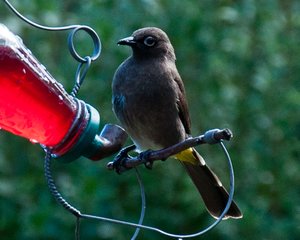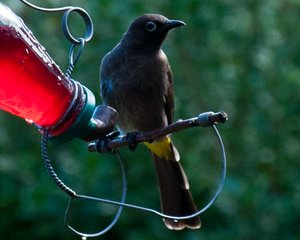Cape Bulbul
Kaapse tiptol. Common endemic resident. Dozens noisily descend on our garden each year when the seringa berries are ripe.
Other observations of Cape bulbul (Pycnonotus capensis)
Comments
A jumble of thoughts on seringa trees
Afraid the tree is in the neighbour's garden, but it does tend to a certain degree to dominate life in our backyard. The birds love it, including raptors and owls, it seems to attract rather interesting butterflies, and we once watched a lovely stripey tailed genet staring at us from the lower brances.
Kleinmond being a holiday town we only saw the neighbour in question for the very first time last weekend... I have to admit I'd rather the berries be spread than discontent so early in the relationship.
Keeping the berries from spreading is thus beyond my control, at least for the moment; even just keeping them out of the dog's bek is nigh impossible. As kids we were taught they're poisonous although suddenly I realise I have no idea about the validity of that.
Perhaps if the bulbuls keep stealing my sunbird nectar juice, they won't need to eat and spread too many berries?
(Actually, I thought that was going to be the comment on this post - the nectar feeder has been known to cause a mild controversy in some circles. What would be the scientific view on feeding wild birds? I certainly don't approve of people feeding mammals, is this any different?)
Syringa
It is only mildly invasive: just so long as you are not any riverine patches it should be fine.
The berries are not poisonous when ripe: but even slightly green they are mildly poisonous.
Feeding birds
What is the difference between feeding birds and mammals or butterflies?
I dont want to get embroiled in the debate - people get too emotional.
The truth is:
* Animal populations are governed by periods of dearth, when most individuals die. By feeding them at the worst you the increase the number that will die during the crunch, or at the worst (depends on your viewpoint) you will increase the numbers that survive the crunch. Of course, if you feed them for a few months and then stop for a week or two (holiday or illness) then you are creating a dearth which may result in deaths.
* Whats the difference between providing nectar/fruit/seed in a bottle/table or planting plants that do the same? (people have some hunch that natural is better, but nectar is primarily sucrose and glucose & fructose, and the birds get their non-energy supplement from hawking (sun) or gleaning (others) insects anyway). And whats the difference between you stopping feeding when you go on holiday and the plants stopping flowering?
I might think carefully about feeding primates, but otters, genets, mongeese I would treat as I would the birds.
Mm.
I suppose we like to think our impact is huge, when often nature just carries on making the most of whatever is available, be it our feeders, gardens or nothing. I've read that the nectar feeders cause digestive problems but that does seem a tad dramatic to me, although I really just don't know.
I do think it's important to carefully consider our actions, especially in a time and place where one unthinking dufus can unwittingly wipe out a species.
The real problem
The real problem is the cold, calculated and devious developer / entrepreneur.
But I dont see how us being careful will help any dufus.
We just have to be vigilant, educate the dufus and outwit the deviants.
Are they still applying annually to have the Fynbos north of Brightwood turned into a golf course?
Being careful means I'm not the dufus
As far as I know the golf course extension remains a risk, although my sources are limited to Kleinmond's grapevine/tannie network. It would be good to actually find out the truth about that, and join the protest if necessary. Luckily it seems the green faction in Kleinmond is strong, I doubt that the developers would get away with it. That is such a unique bit of our fynbos, and the growing risk to low lying flat areas surely must be well known to all involved?







Syringa - alien - mildly invasive!
And you are happy with them spreading the Syringa berries all over the neighbourhood?